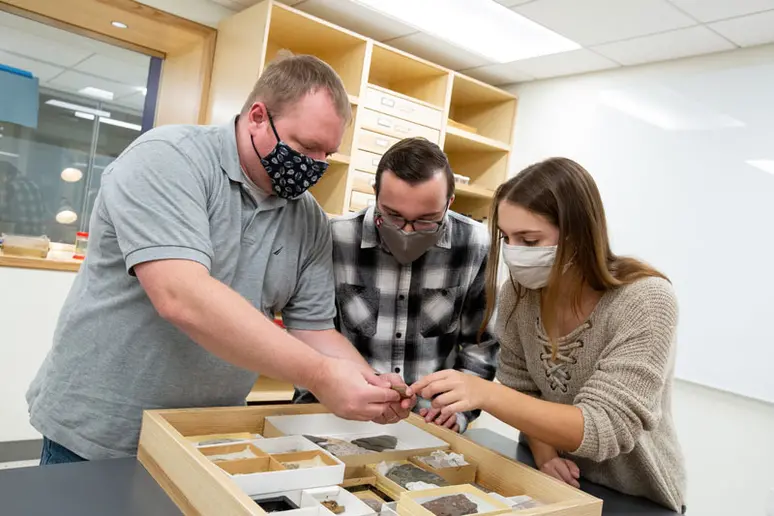

Emma Van Houte and Michael Bradbury, with their research advisor, Dr. Thomas Hegna.


Emma Van Houte and Michael Bradbury, with their research advisor, Dr. Thomas Hegna.
Two seniors – Michael Bradbury, who is majoring in Geology, from Rochester, N.Y., and Emma Van Houte, Environmental Sciences, from Liverpool, N.Y. – will present findings from their research projects at the annual conference of the Geological Society of America in Portland, Ore., Sunday through Wednesday, Oct. 10 to 13.
In “Small Shellies in the Late Cambrian? – Enigmatic Silicified Shelly Fossils from the St. Charles Formation, Late Cambrian (Furongian) of Southeastern Idaho, USA,” Mr. Bradbury was focused on trying to constrain, or check, the identify of some unusual fossils from the Upper Cambrian of Idaho, estimated to be 500 million years old.
The fossilized plates studied by Bradbury are seemingly unknown to the rest of the scientific community, Bradbury explained. They don’t quite match any known animal from the time period which, based on a location in the upper Cambrian of Idaho, would be 500 million years ago, and have left unsatisfactory or uncertain answers when discussed with other paleontology experts, he said.
After comparing these plates to possible fossils from other animals, it was concluded that the mystery plates didn't match any of the possibilities, Bradbury explained. More research needs to be conducted on the plates to better understand what they are, he added, as well as more scientific minds to add a new perspective for viewing these bizarre fossils.
“The goal of this research is less to find out what these plates belong to, and more about getting these mysterious plates out into the scientific world,” Bradbury explained. “That way we can get more minds on the matter to begin serious debate of what these strange plates could be.”
“The goal of this research is less to find out what these plates belong to, and more about getting these mysterious plates out into the scientific world,” Michael Bradbury explained. “That way we can get more minds on the matter to begin serious debate of what these strange plates could be.”
Bradbury’s research included photographing the plates to be presented at the GSA conference. Bradbury plans to continue his study of paleontology in graduate school.
“New Genus and Species of ?Parthenogenic Anostracan (Crustacea, Branchiopoda, ?Thamnocephalidae) from the Cretaceous Koonwarra Fossil Beds in Australia,” Ms. Houte’s project, describes a set of fossil fairy shrimp from the Cretaceous of Australia. They seem to be an all-female population, as there are no male specimens.
This sort of unisexual reproduction is rare, but not unheard of in fairy shrimp, said Department of Geology and Environmental Sciences Assistant Professor Thomas Hegna said. This is the first time it has been documented in the fossil record.
Finding characteristics that are similar or that set apart the Anostracan fossils from the Koonwarra fossil bed from other Anostracan fossils and modern fauna and classifying and possibly renaming the fossil Anostracan from the Koonwarra Australian beds were goals of Houte’s research.
“The Anostracan fossils seem to be the only pathogenic Anostracan in records,” Houte explained. “This is important in understanding how the species came to populate early Australia.”
Houte indicates the fossil record of Anostracan crustaceans is poor, with only six formally described species to date. The Cretaceous Koonwarra fossil beds in Australia contain a new species of Anostracan, or fairy shrimp. The Koonwarra fossil beds are known for their exceptional faunas of fish and insects from a freshwater lake environment. Previously, the Anostracan specimens from Koonwarra were described in open nomenclature as an indeterminate Anostracan, Houte explained. This newly described fairy shrimp species is notable in that all specimens are either females or juveniles, with no known males, based on approximately 40 specimens. This suggests that the species may have a parthenogenic mode of reproduction.
The research compiled by Houte, who would like to attend graduate school and then work in conservation, possibly with zoos, is close to submission for publication in a scholarly journal.
Both students began their research in the spring semester with Dr. Hegna, their research advisor, who will accompany them at the GSA conference.